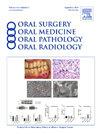COVID-19−associated mucormycosis (CAM): a case series
IF 2
3区 医学
Q2 DENTISTRY, ORAL SURGERY & MEDICINE
Oral Surgery Oral Medicine Oral Pathology Oral Radiology
Pub Date : 2025-02-04
DOI:10.1016/j.oooo.2024.11.012
引用次数: 0
Abstract
Clinical Presentation
We present 3 cases of COVID-19−associated mucormycosis diagnosed on cone beam computed tomography (CBCT) images from 3 endodontists in private practice. Patient 1 presented with paresthesia of the anterior maxillary region. Patient 2 presented with swelling of the anterior maxilla. Patient 3 was asymptomatic. All 3 patients were male in the age range of 58-64 years. All had a history of recent, previous COVID-19 infection. CBCT images of all 3 patients revealed irregular, ill-defined, osteolytic, predominantly radiolucent lesions in the anterior maxilla.
Differential Diagnosis
Differential diagnosis includes malignancy, other infection such as osteomyelitis, and other fungal infections (actinomycosis or candidiasis).
Diagnosis and Management
Diagnosis of a mucormycosis requires clinical examination, imaging studies such as CBCT and magnetic resonance imaging, histopathology, and culture of the fungal hyphae. Treatment and management of mucormycosis includes reversal of risk factors, surgical debridement and/or resection, and systemic antifungal therapy. In cases treated with surgical resection, fabrication of an obturator and/or prosthesis is required.
Conclusion
Mucormycosis is a serious but rare fungal infection caused by a group of molds called mucormycetes. A classic clinical sign of mucormycosis is the rapid onset of tissue necrosis with or without fever. Necrosis is the result of invasion of blood vessels and subsequent thrombosis. The overall mortality rate is approximately 50%. Mucormycosis has traditionally been rare in relation to the oral and maxillofacial region. However, with the advent, spread, and continued presence of COVID-19, COVID-19−associated mucormycosis is an infection of which dentists need to be aware and diagnose early. There is an increased incidence of these cases in patients with associated uncontrolled diabetes and corticosteroid use. Early identification and treatment can lead to better outcomes.
求助全文
约1分钟内获得全文
求助全文
来源期刊

Oral Surgery Oral Medicine Oral Pathology Oral Radiology
DENTISTRY, ORAL SURGERY & MEDICINE-
CiteScore
3.80
自引率
6.90%
发文量
1217
审稿时长
2-4 weeks
期刊介绍:
Oral Surgery, Oral Medicine, Oral Pathology and Oral Radiology is required reading for anyone in the fields of oral surgery, oral medicine, oral pathology, oral radiology or advanced general practice dentistry. It is the only major dental journal that provides a practical and complete overview of the medical and surgical techniques of dental practice in four areas. Topics covered include such current issues as dental implants, treatment of HIV-infected patients, and evaluation and treatment of TMJ disorders. The official publication for nine societies, the Journal is recommended for initial purchase in the Brandon Hill study, Selected List of Books and Journals for the Small Medical Library.
 求助内容:
求助内容: 应助结果提醒方式:
应助结果提醒方式:


